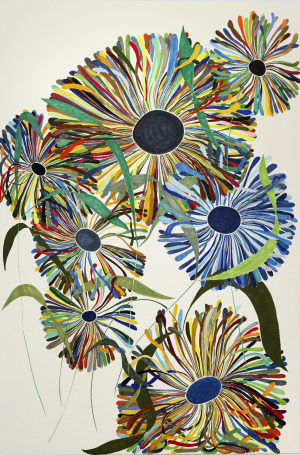How could murderous African buffaloes have been cajoled into
cow evolution?
This steak shaped country where I was born even has a steer
on its escudo [coat of arms]!
How can I not eat beef down here?
I was lost in these thoughts when dad in his habitual drunkenness
announced,
“No one has ever eaten as many lemons as I have.”
He went on to explain that when he was a kid a neighbor played a joke on
him by saying my dad could eat
as many lemons as he wanted from the neighbor’s backyard tree.
The neighbor miscalculated my dad’s hunger because he supposedly lived
on lemons for years.
It took me weeks to realize that lemons were the new memory I needed to
replace the Pavlovian conditioning to cow grilling.
The point is that sometimes we have to abandon habits not by
intellectual force but by emotional coercion.
And artists crave habits.
I don’t mean the cliché of the drug-addict alcohol-binging
multiple-sex-partner artist,
but the reality of artists needing life habits to work.
I remember a painter friend excitedly speaking about visiting another
painter, the rare successful type,
who had tables and tables covered with every conceivable brush.
Somehow it bothered me, like eating cows.
Last year when I had the chance to show in Venice, I chose to actually
live and work in the city.
I completed all my Venetian drawings with Office Depot pens and a red
pencil a friend had given me.
Borrowed a scanner in an architect’s office and showed my drawings as
manifesti
[posters] commercially printed and placed all over the city.
The main material for my installations was used bed sheets donated by my
neighbors.
Today I travel with even fewer tools after literally giving away my US
studio.
And today’s quotes are: “La vida sólo se puede comprender mirando hacia
atrás;
pero sólo se puede vivir mirando hacia delante,” Kierkegrand speaking in
Spanish
[By looking at the past, we know ourselves, but we live by looking at
the future]
and “The same modernization that removed time from the voyage also
removed from it the reality of space,”
Guy Debord, The Society of the Spectacle, 1967.
It is obvious at some level that limiting one’s tools fosters creativity
and engagement with the existing spaces
and materials. I am saying we artists should strive to be sparse.
Not only to accumulate tools and materials, but also to actively trim
down and forget.
Be lean. Save the planet. Throw down the ladders that took us where we
are (Deleuze paraphrase).
That driver slamming the brakes could be a sculptor picking up another
piece of useful junk.
Maybe he should give away his truck. I learned in Uruguay to love lemons
and to confront mean black dogs with a stick.
And I felt the beauty of sparse expression in Montevideo’s “Llamadas.”
The Llamadas (literally "calls" or "flames")
are cultural heritage, precursors to tango, and a touristic attraction,
but truly most locals find the affair totally boring, ask my father.
You see, it is ‘monotonous’ music. Sounds born out of slaves forced into
silence.
Much like music in the US being determined by the quilting of race and
music.
To this day, men and some women march slamming their drums.
Rows of seven, three tones of drums, they go on deafening and voiceless.
On the big days, I joined them up and down the official parades…
But I preferred to pass the TV cameras and dignitaries to find the
drummers on the darkened streets preparing for the spectacle.
Dancers spread on the pavement resting from their high heels.
The video on the very top opening with a ‘sun’ shot shows drummers
stretching the drums’ skins by a fire.
They were part of the last “comparsa” [group] to march on the first day
of parades.
Stuck way past midnight, they were no doubt the unknowns.
They couldn’t afford better than just white for their drums and attire.
Groups deck out for the official parades and events, but the many days
of rehearsals previous to the parades are truest.
See video below for those rehearsing without beads or paint on their
bodies.
Note that the sound is slightly distorted because I didn’t have the tech
to capture the high volume.
You can actually feel the waves of air carrying the unamplified sound
striking your body. Goose bumps.
Me? I recharged my batteries aplenty in Uruguay.
I could have stayed plugged in the wall, I had it all: house, beach,
stray dog, hot girl, creaky red bike,
and lots of firewood stacked by the aloe plants I kept finding uses for.
But rechargeable batteries give us mobility so I am back in New York
determined to continue breaking bad and good habits.
And I have experienced a lot of sparse artwork in the last couple of
weeks.
From the Greater New York gathering at PS1 to Jeff Koons’ meticulously
curated “Skin Fruit” at the New Museum
through Gagosian showing the last Monet paintings.
The Whitney Biennial was definitely sparse
(see Glasstire review)
with a reduced roll of artists competing not to fill up their large
assigned spaces.
For instance, Charles Ray didn’t surprise with a life size fire truck or
a larger than life whitened naked boys holding a phallic frog.
Nope, he chose to show lots of his intimate flower drawings.
-
Charles Ray, Untitled, 2009. Ink on paper, 47 x 31 1/2 in. (119.4 x 80
cm). Collection of the artist; courtesy Matthew Marks Gallery, New York
Yes, there are risks in this sparsing of oneself, even grammatical ones,
that’s the point.
All videos by Jorge Misium.
Jorge Misium is
an artist whose journey has been home for the last year and who has
been solely living on lemons.




